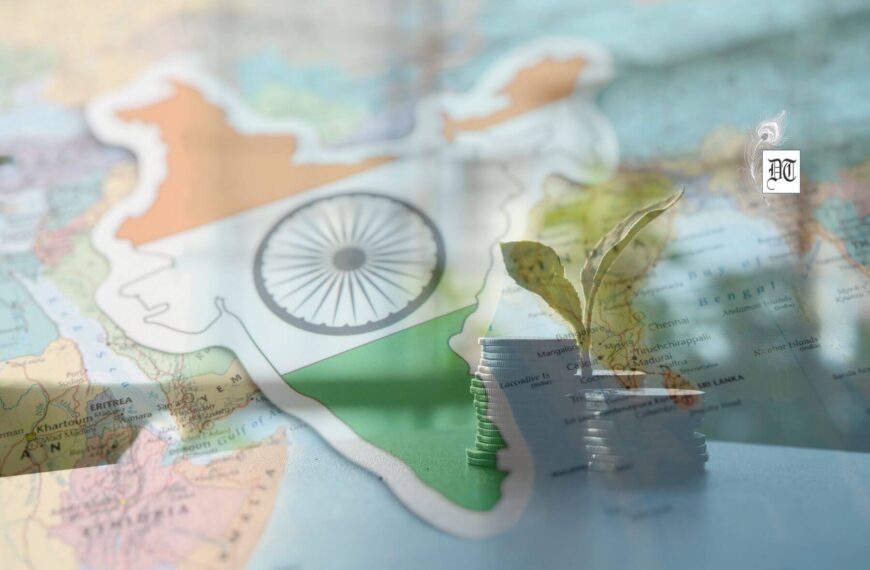To circumvent the trade war, China should increase its overseas investment in low-cost countries and re-route its exports to the USA. India can become a preferred destination for Chinese investment. For the past few years, China has emerged as a big-ticket investor in India, despite security concerns. In 2015, Chinese investment in India leapfrogged eight times and Beijing became the eighth-biggest foreign investor in India. Here’s an analysis, for Different Truths.
Donald Trump is not the first US President to hatch a trade war against its rival. In 1985, Ronald Reagan took an assault on Japan, skyrocketing the yen value to nail Japanese exports. The challenge was to uptick the yen value artificially in a coterie of five countries under the Plaza Accord. Reason! Intransient Japan refused to buckle down to reduce exports, which caused wide trade deficit with the USA. Now, it is China’s turn, for defying US warning on the trade deficit, causing damages to US industry and employment.
Nevertheless, the paradox of the two trade conflicts is that while Japan abstained from taking any retaliatory measure against USA’s attempt for artificial hook up of the Japanese yen, China is assertive to retaliate against the US actions on equal terms. In a counter move, China decided to slap 15 percent tariff on 120 items of products imported from the USA, including fruits and related products and 25 percent tariff on eight products, including pork and related products.
Hit by the Japanese yen appreciation, Japanese products lost cost competitiveness. Till 1985, Japan was the biggest contributor to USA trade deficit. In 1985, Japan accounted for 37 percent of USA’s total trade deficit in goods. Instead of wading in retaliation, Japan decided to thwart USA’s move by shifting plants in low-cost countries, such as Malaysia, Indonesia, Thailand, Philippines and in the USA to balance the trade deficit. Later, China became the hotbed for Japanese manufacturing.
As a result, Japanese investment overseas soared. It spiked by over 430 percent in 1988, three years after the Plaza Accord and continued to spur till Japan countered the bubble burst in 1993.
While both Japan and China are export-based economies and vulnerable to trade barriers, the difference between the two is that any trade sanction on China may boomerang on several US companies. A number of US companies invested in China for cheap production and re-import into USA or export to third countries. Who wins and who loses will be determined after the tariffs will actually be imposed.
Given the relation between USA-China and USA–Japan from the angle of political and economic levels, China has more leverages to retaliate against the USA than Japan. Japanese hands were tied as it was a close ally to the USA. Besides, USA was the biggest importer of Japanese goods in 1985. One-fifth of Japanese exports were shipped to the USA.
In contrast, politically China is an adversary of USA. Even though the USA is the biggest importer of Chinese goods and not vice versa, there are ample reasons which may haunt USA exporters if China takes retaliatory measures. China is the biggest buyer of US soybean. About 60 percent of US soybean exports go to China. China is the biggest buyer of US sorghum. Trump administration stuck a compensatory trade deal last year with China to balance the trade. The USA would export beef and natural gas to China against imports of cooked poultry. The deal may turn dud if China retaliates. China may divert purchasing of Boeing aircrafts to Airbus. In November 2017, a purchase deal of 300 Boeing was made by China, which is the biggest buyer of US Treasury bonds worth the US $ 1 trillion. Selling a chunk of these bonds will distort the market. China has a close monopoly of 17 rare earth minerals. They are used for cell phones, displays, automobiles and atom batteries. Any sanction of these minerals may prove a hardship for US industries.
Nevertheless, USA is more significant to China than China to the USA in terms of economic dependence. China is an export-based economy and not vice versa. In 2016, exports accounted for 18.6 percent of Chinese GDP, compared to 11.9 percent of USA’s GDP. The USA is the biggest destination for Chinese exports, accounting for 18 percent of Chinese exports in 2016. In contrast, China accounted for 7.5 percent only of USA exports in 2016.
Given the unbalanced economic inter-dependence, China should be wary of USA’s onslaught on its currency management as the next step for retaliation, taking a leaf from the experience to thwart Japanese exports in post Plaza Accord. The USA may mount further pressure on Chinese renminbi, alleging that it has been kept under-valued in proportion to Chinese growth. USA has already forced China to unpeg its currency to US dollar and caved into floating rates in a basket of currencies. Since then Chinese renminbi value spurred by over 22 percent while Chinese wages leaped high. Chinese goods fell prey to expensive products. Toeing the Japanese formula, China opted for a go-out policy by investing abroad instead of investing domestically. Chinese out-bound investment surpassed its in-bound FDI. Chinese investments abroad surged to the US $ 170 billion in 2016, against inward FDI of US $ 134 billion. This exemplifies that China lost the paradise of cheap production, similar to Japan in post-Plaza Accord.
Does this mean that China’s heydays are in jeopardy? Given the USA’s significance as the linchpin for China’s export and holding the mantle for global currency balancing, can China afford to retaliate against the USA and make a smooth run of its economic growth?
To circumvent the trade war, China should increase its overseas investment in low cost countries and re-route its exports to the USA. India can become a preferable destination for Chinese investment. For the past few years, China has emerged as a big ticket investor in India, despite security concerns. In 2015, Chinese investment in India leapfrogged eight times and Beijing became the eighth biggest foreign investor in India. In 2016, Chinese companies proposed the US $ 2.3 billion worth of investment in the country.
In mobile phone manufacturing, China has already established a strong base in India. More than half a dozen Chinese mobile manufacturing companies have set up their plants in India Upstart brands like Goinee, LeECo, Oppo, Vivo, Meizu, One Plus and Coolpad have also announced their plans for India.
India’s attraction snowballed after China lost its status as the low cost workshop of the world. According to FDI Intelligence, an outfit of Financial Times, India replaced China in receiving FDI in Greenfield projects in 2015. This unraveled India’s strength in attracting FDI among the low cost countries.
Subrata Majumder
©IPA Service
Photo from the Internet





 By
By

 By
By
 By
By